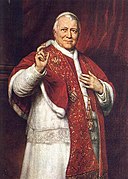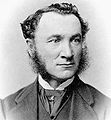Innovations in men’s fashion of the 1870s included the acceptance of patterned or figured fabrics for shirts and the general replacement of neckties tied in bow knots with the four-in-hand and later the ascot tie.
From 1870 onwards, the men’s costume consists of a high-closing jacket, straight cardigan and trousers, mostly of the same material. The jacket is straight of model, or slightly longer and fitted with rounded-off pajamas. The legs are wider. The white shirt, symbol of the man who does not work with his hands, has an upright collar and buckled points. The shoes are flat and up to the ankles, with laces. The hair is short, and the man often has a mustache, point or ring beard, and sideburns. In addition to the top hat, the bowler hat (Homburg) and the straw hat are becoming more popular.
The outfit remains sober but gains in size.
The coats are long and wide.
The tie gives way to the bowtie.
The top hat is always de rigueur.
Coats and trousers
Frock coats remained fashionable, but new shorter versions arose, distinguished from the sack coat by a waist seam.[clarification needed] Waistcoats (U.S. vests) were generally cut straight across the front and had collars and lapels, but collarless waistcoats were also worn.
Three-piece suits consisting of a high-buttoned sack coat with matching waistcoat and trousers, called ditto suits or (UK) lounge suits, grew in popularity; the sack coat might be cutaway so that only the top button could be fastened.
The cutaway morning coat was still worn for informal day occasions in Europe and major cities elsewhere. Frock coats were required for more formal daytime dress. Formal evening dress remained a dark tail coat and trousers. The coat now fastened lower on the chest and had wider lapels. A new fashion was a dark rather than white waistcoat. Evening wear was worn with a white bow tie and a shirt with the new winged collar.
Topcoats had wide lapels and deep cuffs, and often featured contrasting velvet collars. Furlined full-length overcoats were luxury items in the coldest climates.
Full-length trousers were worn for most occasions; tweed or woollen breeches were worn for hunting and hiking.
In 1873, Levi Strauss and Jacob Davis began to sell the original copper-riveted blue jeans in San Francisco. These became popular with the local multitude of gold seekers, who wanted strong clothing with durable pockets.
Shirts and neckties
The points of high upstanding shirt collars were increasingly pressed into “wings”.
Necktie fashions included the four-in-hand and, toward the end of the decade, the ascot tie, a tie with wide wings and a narrow neckband, fastened with a jewel or stickpin. Ties knotted in a bow remained a conservative fashion, and a white bowtie was required with formal evening wear.
A narrow ribbon tie was an alternative for tropical climates, and was increasingly worn elsewhere, especially in the Americas.
Accessories
Top hats remained a requirement for upper class formal wear; bowlers and soft felt hats in a variety of shapes were worn for more casual occasions, and flat straw boaters were worn for yachting and other nautical pastimes.
Style gallery 1870–75
 1 – 1870s |
 2 – 1870s |
 3 – 1870s |
 4 – 1872 |
 5 – 1872 |
|---|---|---|---|---|
 6 – 1875 |

7-1873.
|

8-1878
|
1.1870s photo of President Rutherford B. Hayes. His coat and shawl-collared vest or waistcoat have covered buttons. Note functional buttonholes all the way up his coat lapel.
2.Three-piece suit with frock coat, 1870s.
3.Oliver Hazard Perry Morton wears a narrow string tie, 1870s.
4.Gentleman in a railway carriage wears a dust-colored coat, trousers, and collar-less waistcoat with a dark red necktie. He wears a fur-lined overcoat and tan gloves. Britain, 1872.
5.Plate from The Gazette of Fashion shows a fur-lined overcoat (left) and double-breasted topcoat (right) with braid trim and decorative topstitching, 1872. Checked trousers were quite fashionable.
6.Photographer Mathew Brady wears a coat with braid trim on the collar and lapels over a matching waistcoat. His turned-down collar is worn over a four-in-hand necktie. 1875.
7.Canadian legislator John Charles Rykert wears a narrow ribbon necktie and a collarless waistcoat. His coat has wide lapels. 1873.
8.Paris fashion of 1878 features a coat with a contrasting collar, a waistcoat decorated with a watch chain, wide ascot tie, square-toed shoes, and a top hat.
Style gallery 1875–79
 1 – 1875–80 |
 2 – 1876 |
 3 – 1879 |
 4 – 1879 |
 5 – 1879 |
|---|
1.Two-piece lounge suit of tartan wool twill buttons high in front. English lounge suits were typically worn with bowler hats. 1875-80, England, Los Angeles County Museum of Art, M.2010.33.9a-b.
2.Major-General The Hon. James MacDonald is drawn by James Tissot in a slightly fitted, double-breasted topcoat with a diagonally positioned breast pocket and a contrasting collar. His shirt collar is pressed into flat wings and is worn with a wide, dark tie. He wears a top hat and gloves. 1876.
3.1879 photo of American lawman Bat Masterson wearing a three-piece suit and a bowler hat. His cutaway sack coat has a high front closure and is worn buttoned only at the top, over a vest or waistcoat cut straight across at the waist and decorated with a prominent watch chain.
4.Vanity Fair sketch of 1879 shows Sir Albert Abdallah David Sassoon in “morning dress” (formal daywear): grey trousers, dark cutaway coat, white waistcoat, wing-collared shirt and dark tie.
5.British statesman William Gladstone wears conservative clothing; his tall collar is still upstanding, and he wears his tie in a bow knot. 1879.
Fashion in art
 1-1871 |
 2-1873 |

3-1876
|

4-1875
|

5-1878
|
|---|
1.Pope Pius IX, 1871
2.Carol I of Romania, 1873
3.Dance at Le Moulin de la Galette (Bal du moulin de la Galette), 1876
4.Pierre-Auguste Renoir, Portrait of Claude Monet, 1875, Musée d’Orsay
5.The North-West Passage (1878) Tate Britain, London
Necktie gallery
 |
 |
 |
 |
 |
|---|---|---|---|---|
 |
 |
 |
1873 portraits of members of the Legislative Assembly of Ontario illustrate the variety of fashionable neckwear (and facial hair).
Source from Wikipedia
